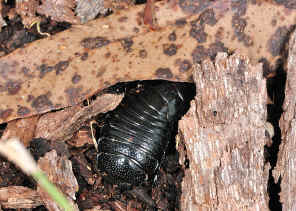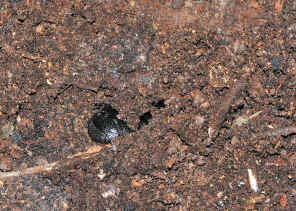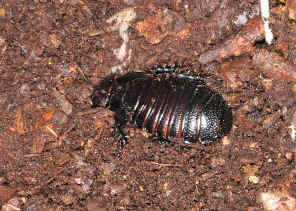Australian Wood Cockroach - Panesthia cribrata
Family Blaberidae
This page contains pictures and information about the Australian Wood Cockroaches that we found in the Brisbane area, Queensland, Australia.

- Body length 40mm
- This cockroach has dark brown to black colours body and short spiny legs. They can be found under moist fallen rotten logs. They live in and feed on decaying wood that they burrow into. They are slow moving. Notice their shiny exoskeleton and spiny legs. The adults are winged but they chew each other's wings off and become wingless.



- They are easily found in moist area in Eucalyptus forests in Brisbane, including the Karawatha Forest and Daisy Hills. Every time we lifted up a rotten log on ground. We always saw a group of cockroaches, usually from five to ten.



- After taking a few pictures and having a good look, we always put the logs back into position to minimize the interrupt to those cockroaches.



- We found the above large Wood Cockroach in Ford Road Conservation Area on Mar 2011. The cockroach was hiding under bark near the base of a large gum tree trunk.



- The abundant wood-eating wood cockroaches are very important in the breakdown of logs in the wet forests. Unlike the other wood feeding cockroaches which have the intestinal protozoa to digest wood cellulose, the Wood Cockroaches utilise amoebae and bacteria to digest the cellulose they eat.



- This nymph, body length 5mm, was doing the 'play dead' trick to cheat predators. It slowly turned over and merged into the dirt after a minute.


- In the above 1st and 2nd photos, notice the very small young cockroaches around and on the adult cockroaches. Photos were taken on May 2011 in Ford Road Conservation Area.



- Australian Wood Cockroaches are in sub family Panesthiinae As all cockroaches in the subfamily, nymphs born alive. Nymphs are golden brown to dark brown in colours.



- Australian Wood Cockroaches live in group. Those cockroaches have some communal organization and they are usually found in groups under rotten logs. Chemical cues appear to play an important role in the association preferences. They seem able to use the chemical cues distinguish between different groups.
- Before we thought this species was the Panesthia australis. After checking the reference materials we believed this is the Panesthia cribrata. Both species have the same common name Australian Wood Cockroaches. Both species are widely spread in the east coast of Australia. The P.cribrata is more common in Queensland.
- Reference:
- 1. Insects of Australia, CSIRO, Division of Entomology, Melbourne University Press, 2nd Edition 1991, p329 (synonym Panesthia laevicollis).
- 2. Grasshopper Country - the Abundant Orthopteroid Insects of Australia, D Rentz, UNSW Press, 1996, p228, plate362.
- 3. Family BLABERIDAE - A.M.E. Roach & D.C.F. Rentz, CSIRO Entomology, Australian Faunal Directory, Australian Biological Resources Study.
- 4. Chemical cues and group association preferences in a subsocial cockroach, Panesthia australis - Billingham, Z.D., Chapple, D.G., Sunnucks, P., and Wong, B.B.M. (2010), Australian Journal of Zoology 57, 385–390.
